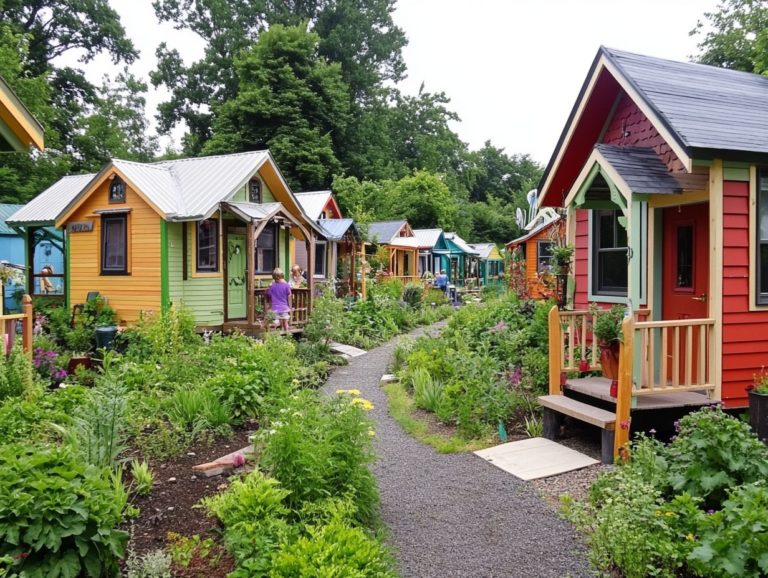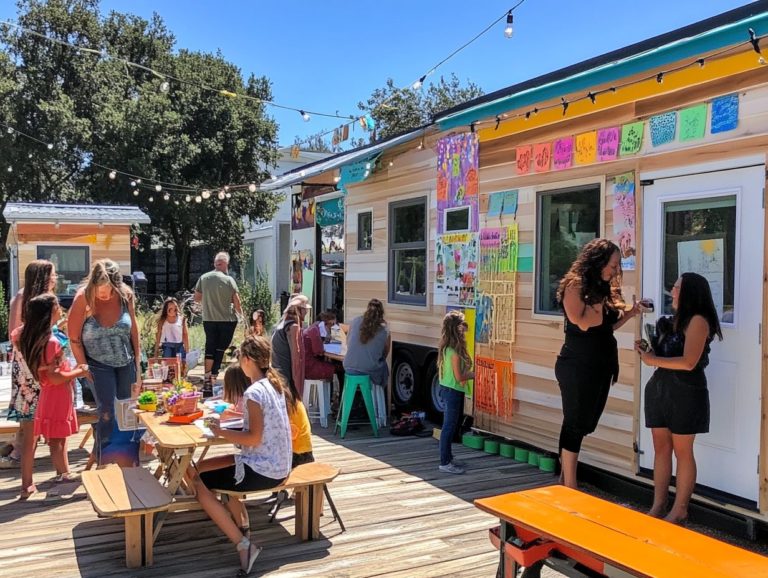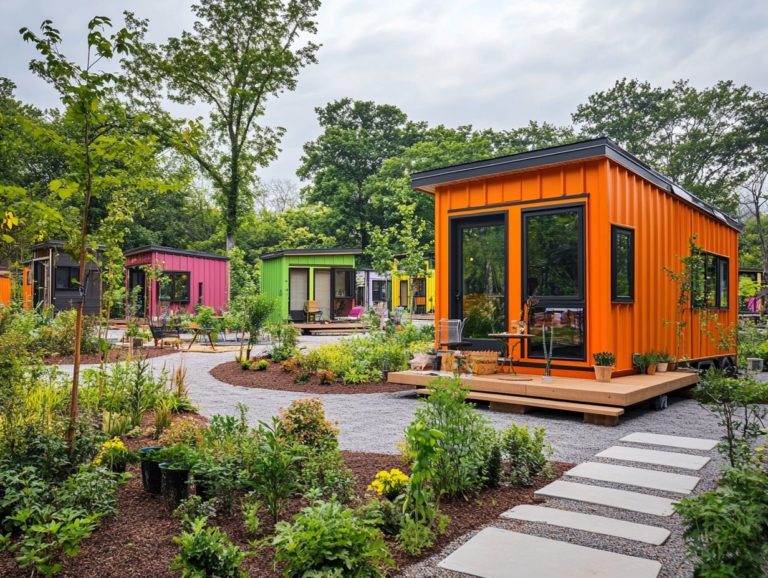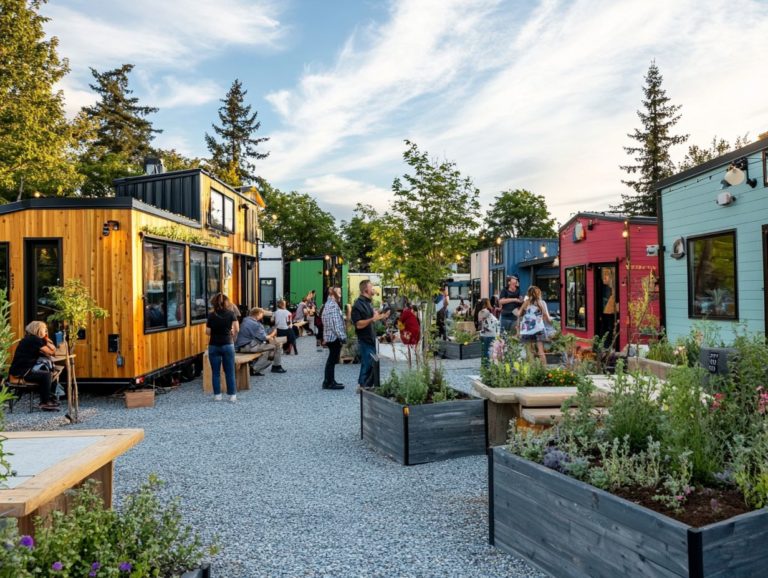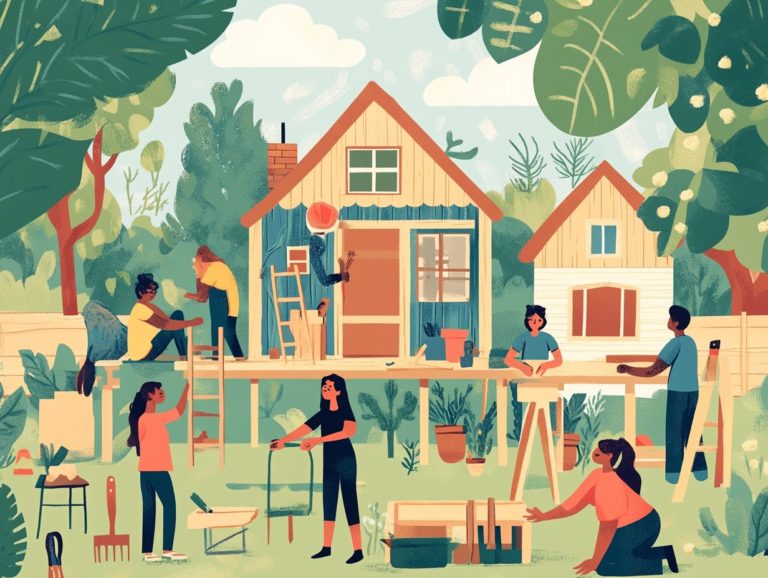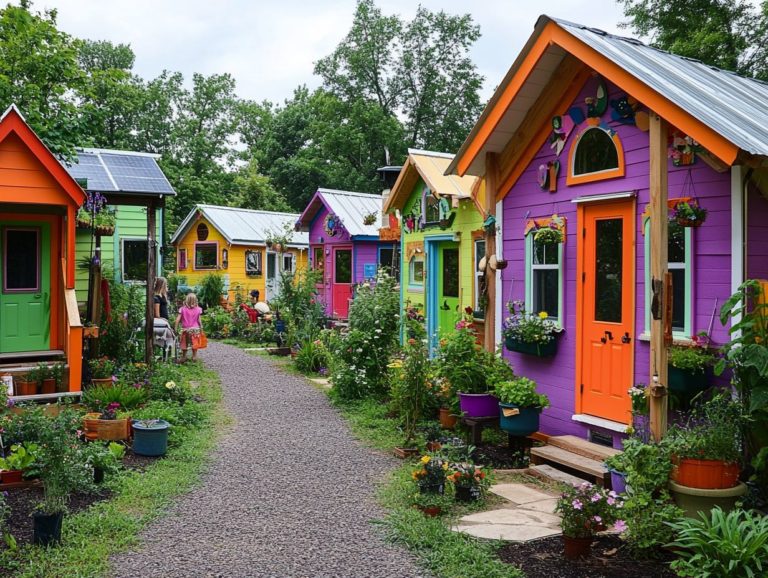The Evolution of Tiny House Communities
Tiny house communities are gaining traction around the world, presenting an innovative solution to the challenges of modern living. As you seek financial freedom, environmental sustainability, and a genuine sense of belonging, these compact homes are reshaping your perceptions of space and community.
This exploration delves into the rise of the tiny house movement, which continues to inspire many communities. It showcases various types of tiny homes, including homes built just for you and other innovative structures, highlighting their benefits, challenges, and diverse forms. Whether you’re contemplating joining one or considering the idea of starting your own, there s a wealth of insights waiting for you in the realm of tiny living.
Contents
- Key Takeaways:
- The Rise of Tiny House Communities
- The Benefits of Living in a Tiny House Community
- Challenges and Controversies of Tiny House Communities
- Types of Tiny House Communities
- How to Join or Start a Tiny House Community
- Frequently Asked Questions
- What is the history of tiny house communities?
- What factors have contributed to the evolution of tiny house communities?
- Are tiny house communities legal?
- What are the benefits of living in a tiny house community?
- How have tiny house communities changed over time?
- What Does the Future Hold for Tiny House Communities?
Key Takeaways:
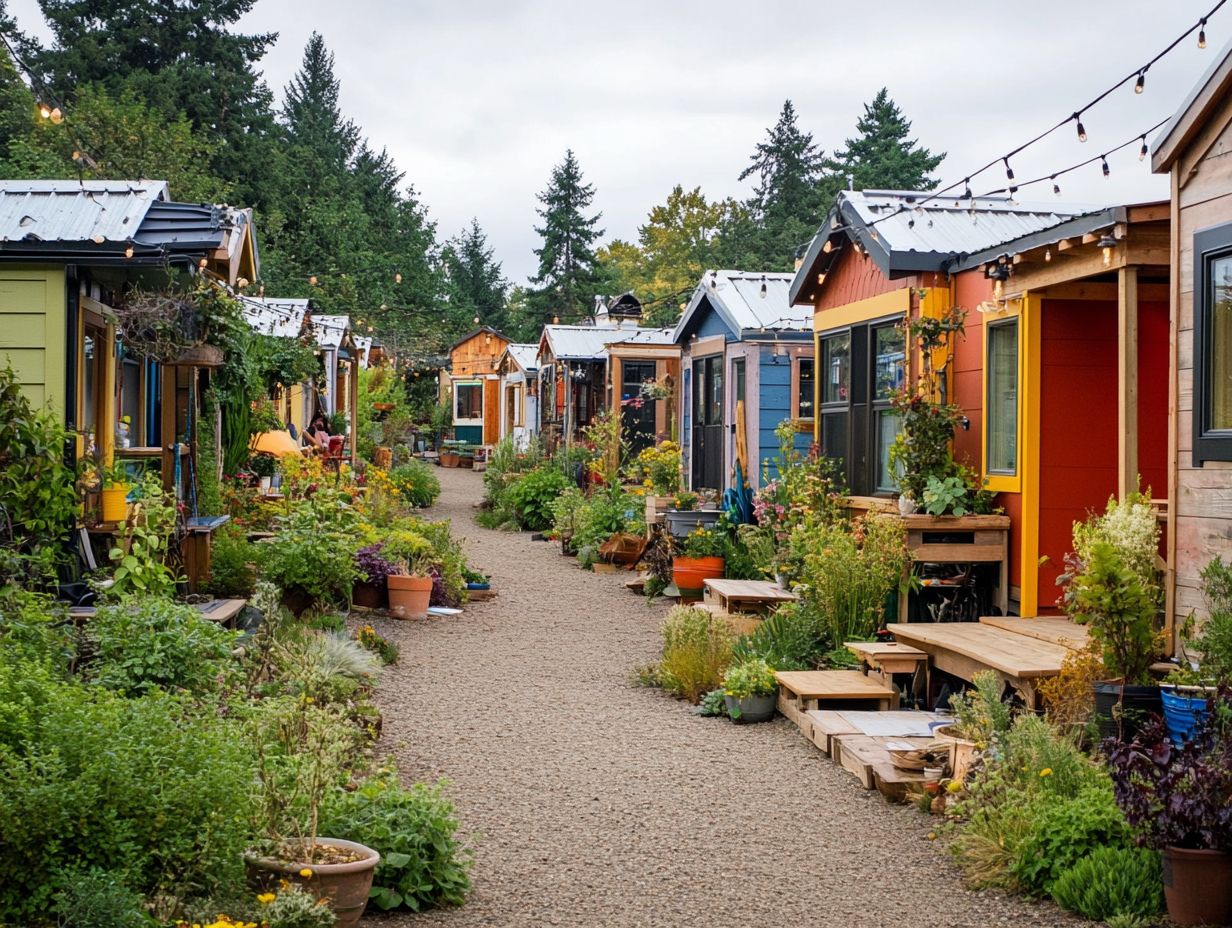
- Tiny house communities offer a supportive and sustainable lifestyle with shared resources and lower costs, making them an attractive option for those seeking a simpler way of living.
- While tiny house communities face challenges such as zoning and social stigma, they continue to gain popularity and offer a sense of belonging and camaraderie for residents.
- There are various types of tiny house communities, including co-housing communities, eco-villages, and mobile home parks, each with their unique features and benefits.
The Rise of Tiny House Communities
The emergence of tiny house communities signifies a profound transformation in living standards and societal values throughout the United States. As you witness more individuals and families embracing the tiny house movement, a significant cultural shift, you’ll see a strong focus on environmental sustainability, affordable housing options, and minimalist living.
This movement shows how society is evolving towards sustainability, reflecting new values and promoting a sense of community. It highlights the importance of reducing one s environmental footprint, which means minimizing waste and resource use, and emphasizes harmony with nature.
Innovative housing solutions, from custom-built homes to shipping container homes, are becoming increasingly popular and are at the forefront of this change. They invite you to rethink what home truly means in today s world.
Exploring the Popularity of Tiny Homes
The surge in popularity of tiny homes among millennials drives the demand for tiny living. It presents an enticing, affordable housing solution that aligns perfectly with your desire to minimize your environmental footprint and embrace a sustainable lifestyle.
This trend is more than just a financial decision; it represents a significant shift in values, reflecting a heightened awareness of resource consumption and waste. Recent studies reveal that approximately 68% of tiny home owners cite financial reasons as their primary motivation, with many managing to secure homes for under $30,000.
As younger generations increasingly prioritize experiences over material possessions, the minimalist lifestyle is gaining traction among millennials. In fact, surveys show that 55% of millennials are actively considering downsizing their living spaces.
This renewed appreciation for simplicity signifies not merely a housing solution but a deeper cultural transformation towards sustainability and mindful living.
The Benefits of Living in a Tiny House Community
Residing in a tiny house community presents a wealth of benefits. You’ll experience strengthened community support, access to shared resources, and notable environmental and financial advantages.
These factors collectively lead to significantly lower overhead costs, allowing for financial freedom for residents, enhancing your quality of life while promoting sustainability.
Explore the world of tiny house communities and discover how they can transform your living experience!
Community Support and Shared Resources
Community support within tiny house neighborhoods cultivates a profound sense of belonging. It elevates the overall quality of life for residents through shared resources and collaborative efforts.
Imagine communal gardens where neighbors come together to grow vegetables and flowers. They exchange not just produce but also gardening tips and companionship. Picture a tiny house community in Portland, where residents share their gardening experiences. This results in a bountiful harvest that nourishes both bodies and friendships.
Consider the concept of tool libraries. In one Texas community, members established a library that allows residents to borrow items they might use only occasionally, like lawnmowers or power drills. This setup cuts costs and fosters collaboration among neighbors.
Residents frequently reflect on how these shared resources lighten individual burdens. They forge lasting connections, nurturing a vibrant community spirit that enriches their lives.
Environmental and Financial Benefits
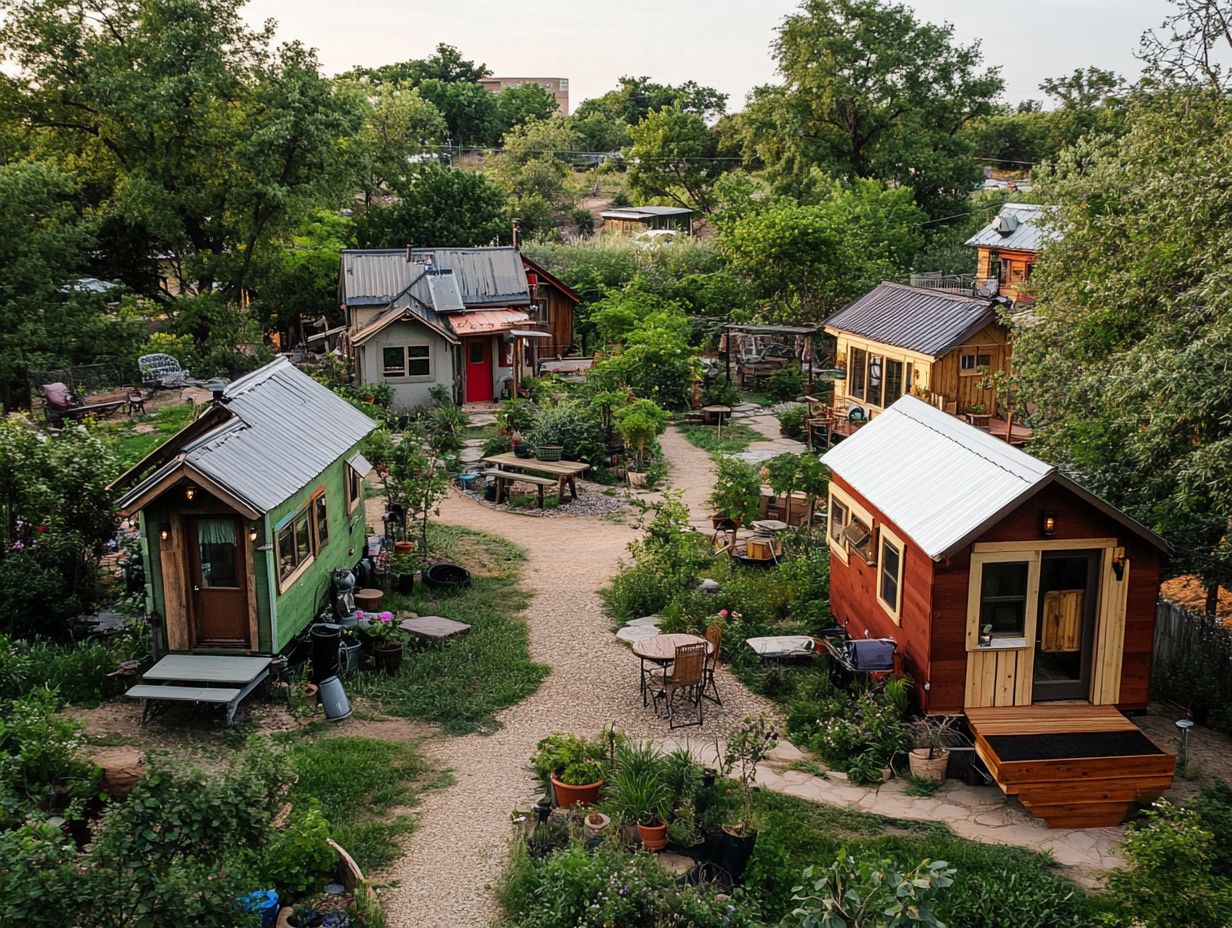
Tiny house communities bring you exciting environmental and financial benefits. They include reduced overhead costs, energy-efficient designs that make living more enjoyable, and access to green energy options that encourage sustainable practices. This makes them an appealing choice for those who are eco-conscious.
By adopting a minimalist lifestyle, you can significantly cut down on waste and energy consumption. This results in a smaller carbon footprint compared to traditional homes. Sustainable living encourages using recycled materials and fosters a community-centered approach, where shared resources help minimize individual consumption.
On the financial front, while the initial investment in a tiny home may seem daunting, the long-term savings on utilities and maintenance can be quite substantial. Many local governments also provide incentives for those pursuing sustainable living. This further enhances the attractiveness and affordability of tiny house communities: a guide for beginners.
Challenges and Controversies of Tiny House Communities
While tiny house communities may be enticing, they encounter a host of challenges and controversies.
- Zoning and legal obstacles often impede their establishment.
- Social stigma and widespread misconceptions surround the concept of tiny living.
Zoning and Legal Issues
Zoning and legal issues present significant hurdles to the expansion of tiny house communities. Many local governments have yet to update their rules about where homes can be built to embrace the tiny house movement.
This challenge becomes particularly clear when you delve into common zoning regulations that impose minimum square footage requirements. These often cap them at an imposing 1,000 square feet, effectively excluding smaller dwellings from compliance. Strict regulations on mobile homes often thwart residents wishing to live in a tiny house on wheels, as many municipalities enforce rigid rules regarding mobile dwellings.
Legal challenges frequently arise around building codes and land-use policies. Advocates for tiny houses often battle against outdated regulations. However, successful advocacy efforts, including grassroots campaigns and collaborations with non-profits, inspire change and promote inclusivity in zoning practices.
These initiatives strive to create a more diverse range of housing options. They pave the way for a brighter future in tiny house living.
Social Stigma and Misconceptions
Social stigma and misconceptions often obscure the tiny house movement, leading to misunderstandings about the lifestyle choices and values held by tiny house dwellers.
You might envision tiny living as a last resort, typically associated with financial struggles or aimless minimalism. However, countless individuals have embraced this lifestyle for various reasons, including a commitment to environmental sustainability and a yearning for greater freedom. Many are also drawn to unique tiny house communities around the world that foster a sense of belonging and shared values.
Consider Sarah, a young professional who swapped her conventional home for a tiny dwelling. In doing so, she not only reduced her carbon footprint but also discovered a deeper sense of community and connectedness.
In an interview, Mark, a retired veteran, shared how downsizing enabled him to invest more in experiences rather than material possessions, effectively debunking the stereotypes often associated with this lifestyle.
Each of these stories underscores a broader cultural shift, highlighting choice over necessity and redefining what it truly means to live well.
Types of Tiny House Communities
You ll find a diverse array of tiny house communities, each presenting its own distinctive living experience and philosophy. From co-housing communities that foster collaboration to eco-villages that emphasize sustainability, the options are plentiful.
Consider park model homes for a more traditional tiny living experience, or explore innovative structures like shipping container homes. Granny pods offer flexible living arrangements, while houseboats create unique experiences on the water. Bus conversions provide a creative approach to mobility, and earthships are examples of sustainable architecture that prioritize energy efficiency. Additionally, it’s important to recognize the importance of sustainability in tiny house communities. Each type brings its own exciting twist to minimalist living, inviting you to explore what suits you best.
Co-housing Communities
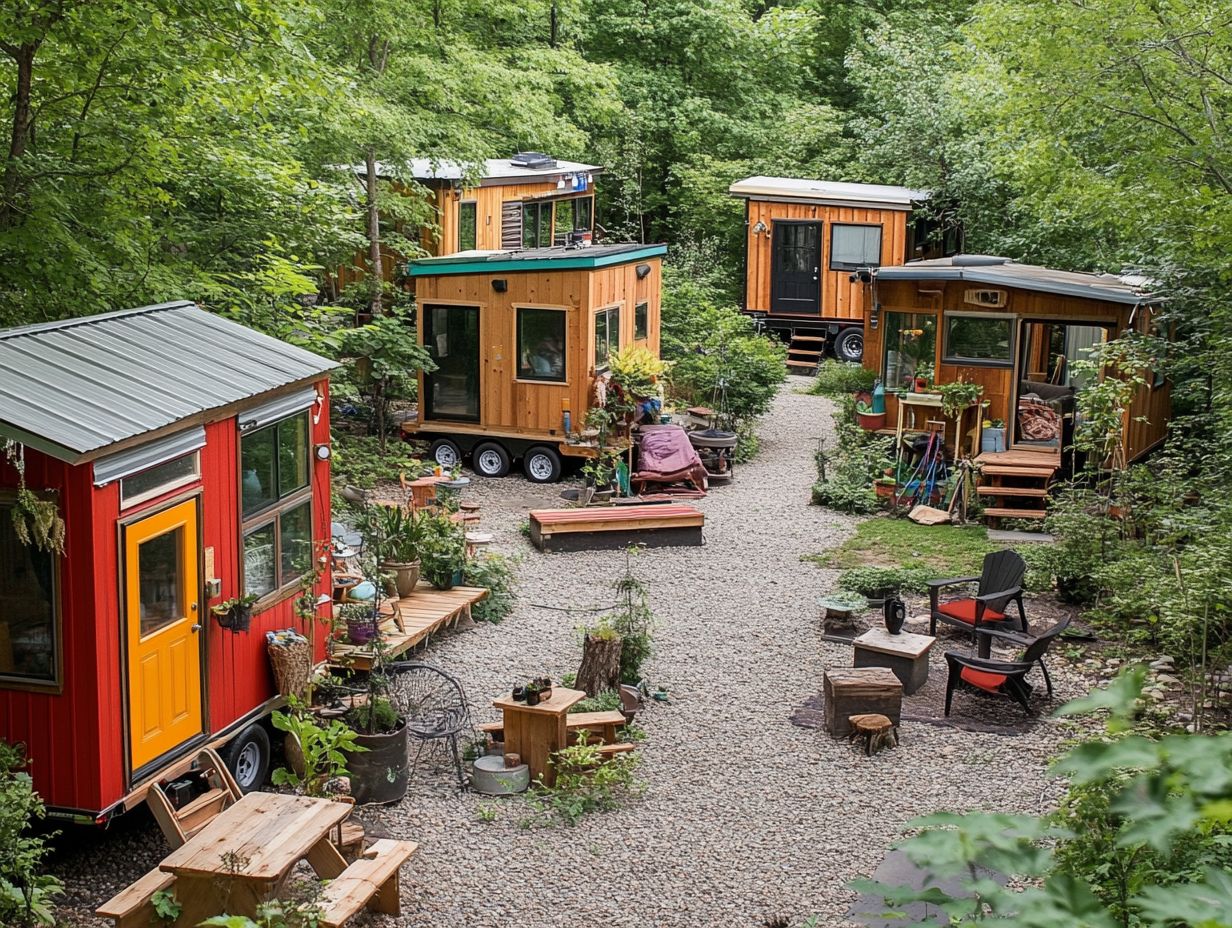
Co-housing communities prioritize collaboration and shared resources, crafting vibrant living environments where you actively engage in decision-making and communal activities.
In these distinctive settings, you and your neighbors embrace the essence of communal living, pooling your skills and perspectives to cultivate a profound sense of belonging. Common spaces, like kitchens, gardens, and recreational areas, are thoughtfully designed to foster interaction and teamwork.
Governance through collective meetings allows everyone to share their voice, making decisions together on matters from planning communal events to managing resource allocation. These shared experiences deepen personal relationships and establish a robust support network, enhancing your quality of life and reinforcing social connections that might otherwise be overlooked in traditional housing arrangements.
Eco-villages
Eco-villages are crafted with sustainability at their heart, designed to minimize your environmental footprint while nurturing close-knit communities.
These intentional communities not only champion eco-friendly living but also emphasize social equity and economic viability. By embracing practices rooted in natural farming, they establish self-sustaining systems that work with nature, ensuring harmony with the environment.
Take, for example, the eco-village in Findhorn, Scotland; here, residents harness renewable energy and organic farming techniques to reduce waste and foster biodiversity. The Ecovillage at Ithaca in New York showcases how participants have effectively integrated communal resources and sustainable building practices.
This commitment not only enhances ecological balance but also strengthens community resilience, positively impacting local ecosystems.
Mobile Home Parks
Mobile home parks offer a unique avenue for affordable housing while nurturing a sense of community among residents. While challenges like property values may arise, many parks thrive and offer a welcoming home!
In these distinctive environments, you ll find opportunities to foster a tight-knit community where experiences are shared and support flows freely. This dynamic makes it easier to cultivate relationships compared to more traditional neighborhoods.
Many parks organize community events, such as potlucks and movie nights, encouraging interactions that enrich your overall living experience.
However, challenges like fluctuating property values and local regulations can complicate matters. Despite these obstacles, some parks have succeeded in creating stable communities where individuals feel a true sense of belonging.
Take, for instance, a case study from Florida, where residents united to advocate for enhanced park conditions; this is an inspiring testament to the power of community in overcoming adversity.
How to Join or Start a Tiny House Community
Joining or starting a tiny house community requires careful navigation through various steps and considerations. You ll need to familiarize yourself with local building rules, build strong friendships within the community, and identify ideal locations that align with your vision.
Each aspect plays a crucial role in ensuring a harmonious and thriving tiny house experience.
Steps and Considerations
When you re thinking about joining or starting a tiny house community, it s vital to follow specific steps and consider essential factors, such as community goals.
Your journey begins with thorough research. Gather information about existing communities, potential locations, and the legal requirements involved.
Engaging in a planning phase is crucial; crafting a clear vision and mission will help align your community’s objectives. Collaborating with like-minded individuals fosters a sense of unity, ensuring that diverse perspectives are integrated.
While navigating challenges like financing and securing permits can feel overwhelming, networking with local officials and seeking architectural guidance can simplify the process.
Through active communication and collective problem-solving, you and your fellow community members can create a thriving tiny house environment that truly reflects your shared values and aspirations.
Frequently Asked Questions
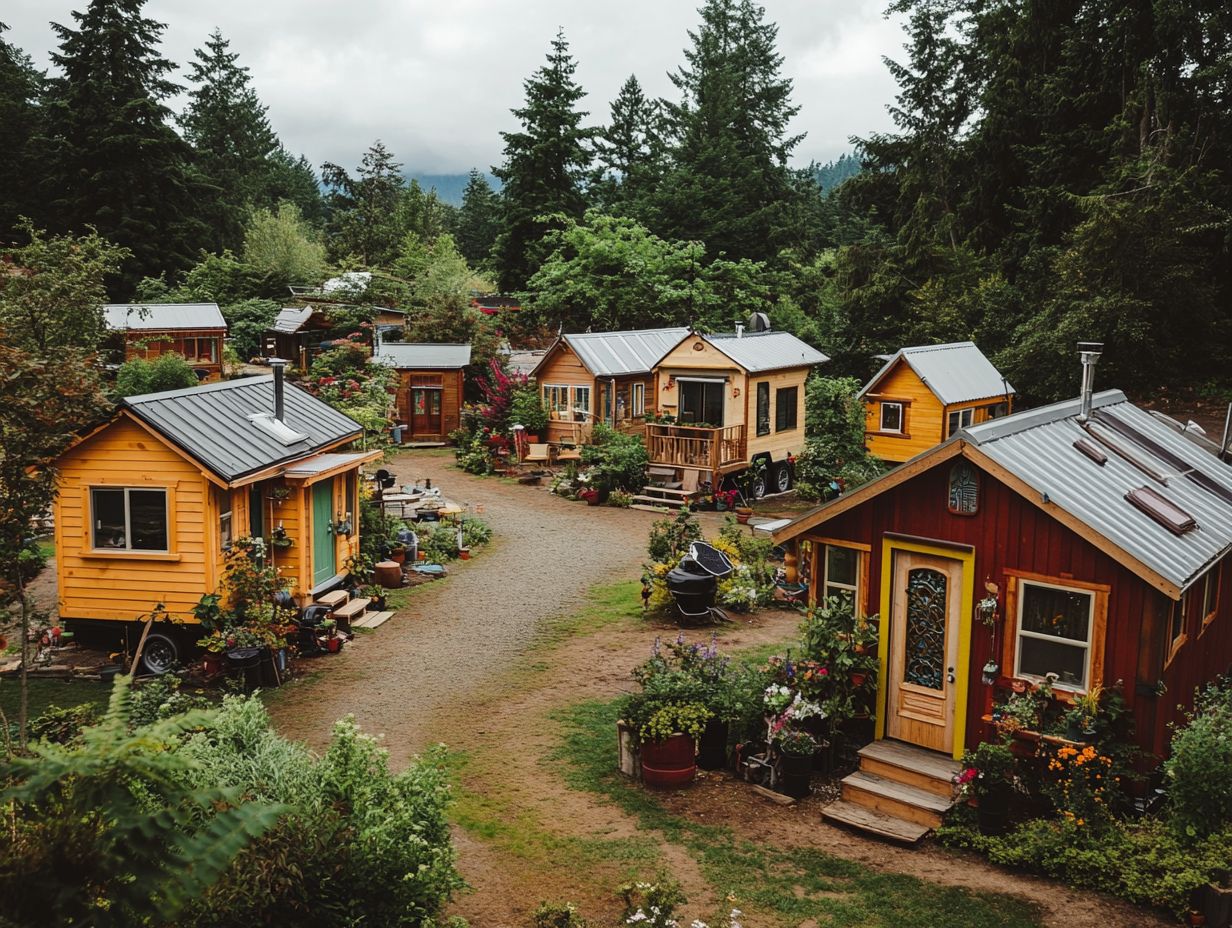
What is the history of tiny house communities?
The concept of tiny house communities dates back to the early 20th century when people began living in trailer parks and mobile home communities. However, the modern tiny house movement started gaining popularity in the late 2000s.
What factors have contributed to the evolution of tiny house communities?
The rise of the minimalist lifestyle, the housing crisis, and the desire for sustainable living have all played a role in the evolution of tiny house communities. The advancement of technology has also helped people connect easily and share ideas about tiny living.
Are tiny house communities legal?
Whether tiny house communities are legal depends on where you live some areas embrace them, while others have restrictions. It’s important to research and understand the regulations in your area before joining or starting a tiny house community.
What are the benefits of living in a tiny house community?
Join a tiny house community for amazing perks like a friendly neighborhood, lower costs, and a greener lifestyle! Residents also have the opportunity to learn new skills and share resources with their neighbors.
How have tiny house communities changed over time?
Tiny house communities have evolved from being primarily for alternative living or vacation homes to being a viable option for permanent housing. They have also become more diverse, with a range of designs and sizes to accommodate different needs and preferences.
What Does the Future Hold for Tiny House Communities?
Tiny house communities have an exciting future ahead! More people are embracing minimalism and sustainable living.
Many developers and city planners explore tiny homes to help people find affordable places to live. However, we must tackle zoning laws and other hurdles to make this a reality.

